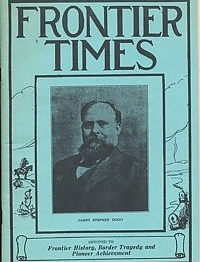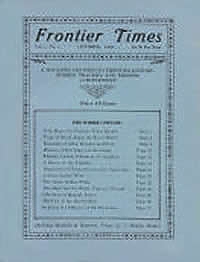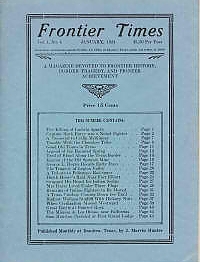By using our website, you agree to the use of cookies as described in our Cookie Policy
Magazines & Instant Downloads
Vol 07 No. 10 - July 1930
James Stephen Hogg
James Stephen Hogg was born in Cherokee county, Texas, March 24, 1851. He was the son of General James Lewis Hogg, a brigadier general in the Confederate army, who came to Texas in 1839. Hogg, like his father, became a conspicuous figure in Texas politics. He served as Justice of the Peace from 1873 to 1876, studied law and was admitted to the bar in 1875, and in 1878 was elected county attorney of the seventh judicial district composed of the counties of Gregg, Rains, Smith, Upshur and Wood, and while acting in that capacity he moved to Tyler, and at the expiration of his term began the practice of law. In 1886 he was nominated-by the democrats of the state for the office of Attorney General. He held this office two terms and in 1890 was nominated and elected Governor of Texas. Here is his story.
How Fredericksburg Pioneers Embalmed Body
Lawrence Toepperwein
True story of the certain settlers of Fredricksburg who were faced with a dilemma – The death of a young man from New York, and the request to ship the body back home for burial. Right there a problem arose. Fredericksburg, in those days, had no undertaker, nor any method of embalming a body. The good citizens and the hotel owner, (the Menger Hotel) who had been friends of the dead youth, held a consultation and it was finally decided to resort to a primitive method to preserve the body so that it could be sent to his family in the East. This is the story.
Buffalo Hunter Tells Of His Early Experiences
W. R. SHOEMAKER, of the Harmony community enjoyed a distinction held by few men anywhere in the entire country-that of having in a year killed a hundred buffalo and with the help of another man skinned over a thousand. This is the very vivid recollection of this hunt which lasted six months and netted him $257.00.
Further Mentions: Bob O'Neal * Erath county * Ike Reed * Sheriff. John Gilbreath * Sheriff J. T. Gilbreath * Fort Driffing in Shackelford County * the Salt Fork of the Brazos * Rath's store * DeLeon *
PIONEER RAILROAD ENGINEER PASSES AWAY
Account of Robert Harvey, commander of Mildred Lee Camp, U. C. V., who was a retired locomotive engineer and was the engineer who pulled the first Texas & Pacific train into Fort Worth from Dallas in the spring of 1876.
Further Mentions: J. D. Starling * Yardmaster R. E. Murray * the Houston & Texas Central Railroad *
Oklahoman Writes Of Early Days In Texas
By J. W. Richardson
This is the sketch of the life of Mr. J. W. Richardson who was born in Jasper County, Missouri, Sept. 21, 1848. His father, F. M. Richardson, moved overland in a two horse wagon to Texas in 1855, settled in Parker County, twelve miles south of Weatherford, the county seat, near the Brazos River, where he built a log cabin in which we lived for a number of years.
Mentions: a man by name of Carter put in a steam mill at Weatherford * Blackwell Cemetery * In the fall of 1865 father moved to Goliad County, Texas * Gonzales County, near Moulton * Port Lavaca * I moved to Coryell County, bought land on the Leon River, eight miles east of Gatesville *
KANSAS MARKS TREE WHERE EDDIE FOY BESTED COWBOYS
By Helen Havely
Foy making his debut in Dodge City in 1878, was the victim of a grim cowboy joke. Believing him to be the 1878 equivalent of "high hat" since he came from the east and was associated with the stage, Dodge City cowboys initiated Foy into the hardened life of the west. They bathed him in a horse trough that stood near the present site of the Dodge City business district, omitting the formality of removing his clothing and then took him to the giant cottonwood where he was "sentenced to hang." Where Foy accepted his fate with a stoical calm and refused to go into a panic for amusement of his tormentors, it was decided that he was not such a tenderfoot as they had supposed. He was released to sing and dance his way to renown.
The Lost Ranger
H. W. Baylor
SOME TIME IN 1888 there came a man to my office in Uvalde. He looked to be 25 years old, a fine specimen of West Texas manhood. He said, "I came here to have a talk with' you. I understand there is a bunch of thieves in this part of the country and I would like to help you round them up. I asked him if he could give me any references. "No," he said. "I don't want to refer to any of my past life, as there isn't any part of it that I am very proud of." His name, he said was Woods and he wasn't from anywhere in particular.
I told him I needed a man that could stand in with the thieves and give me the information that would convict them. "But you will have to be very careful," I warned, "as it would be fatal to you if the thieves suspected you are a spy."
My idea of Woods at first was that he probably was a horse thief himself, so I had to keep a sharp lookout. Anyway, I had to take a chance. He and. I held our meetings at night. I often passed him without noticing him. I kept him around Uvalde until I could write the Adjutant General and get him a commission as a Texas Ranger. When the commission came I gave it to him. He was very proud of it and told me he would make good…
So begins this story of a mysterious man whose subsequent history proved him to be…
Mentions: Piedras Negras, across from Eagle Pass * Bill C * Jess B * Judge Eugene Archer * Ira Wheat * Woods was sent to Kimble County to Sheriff Corder * Ballinger * the Jack Burt ranch, twelve miles south of Uvalde * the Dry Frio * Rocksprings
Tragedy And History Recalled By Luckie
This is the very sad account of the tragic death of the two Rountree children in a large cave on the Rondtree ranch near Richland Springs. They were drowned on May 27, 1880, and Miss Agnes Terry who died later on June 8 was with them. Some of the circumstances connected with the cave and the tragedy are recalled by Mr. Luckie in this story
Mentions: The Terry Cave * the Gibbons ranch near Richland Springs * Shaw * the Gibbons ranch * W. F. Luckie * Mr. and Mrs. Bob Rountree * the San Saba river above Sloan * Alex Hall * W. H. (Uncle Billie) Gibbons * R. T. and Giles Rountree * the old "Big Uncle Grave Yard" at Richland Springs *
Henry Brown Marshal-Killer-Desperado
By Richard Tanner, (Diamond Dick)
One day a Texan rode into town over the old Chisholm trail. He was a bronzed blonde, with a Winchester, two six-shooters, and a record as a fighter. He had been engaged in the John Chisholm war in Texas, and had been a partner of "Billy the Kid." His name was Henry Brown, and he was broke. He had heard that "Bat" Carr wanted an assistant, so he hunted him up. "I hear you want a man to do a night shift on the police," he told Carr that day. "If you do I'm your man." "We bury a marshal here about every forty-eight hours." said Carr, with a laugh at the crowd. "Still if you don't object to that feature of the business, I guess you can have the place."
"Suits me to a dot," was Brown's laconic reply. "Shall I go to work right away?"
The boys learned that a new man was on duty, and prepared to have some fun at his expense. Next day the town turned out and buried two of the would-be jokers. Brown proving to be a tough customer… This is his story
Further Mentions: Jack McCall (Buffalo Curley) * George Flapp * "Bat" Masterson * Dave Payne * Frank Hunt * "Bat" Carr * "Sandy Jim" * Mike Meagher * Ben Wheeler * Newton Boyce * the town of Medicine Lodge * Barney O'Connor * Cedar Canyon * Caldwell, Kansas *
MORSE OFFERED TEXAS HIS TELEGRAPH INVENTION
Had the fathers of the Republic of Texas been far-sighted enough to have accepted the offer of Samuel F. B. Morse of his invention, the telegraph, Texans might today be entirely free from the burden of taxation. The world-wide royalties from the telegraph would not only pay all the expenses of State government, but would have created a sinking fund of many millions.
The early Texans mistook Morse for a dreamer or a fanatic-the telegraph being beyond their imagination. Texas did not then acknowledge the tender of the splendid gift, as evidenced by a letter on file in the archive department of the State, written by Morse in 1860 to the Governor, Sam Houston, in which the offer was withdrawn. The letter is reproduced in this story.
The Adventures Of Big-Foot Wallace
By John C. Duval. First Published in 1870(Continued From Last Month)
This is the Third of a fifteen-part installment series of this quintessential Texan hero, frontiersman, Indian fighter, soldier, patriot and Mier captive. Duval does a masterful job capturing the character and uniqueness of the man and advantageously borrows heavily from Wallace’s own personal diaries, quoting from them at length. Wallace, from the old Scottish hero-heritage of the Wallace and Bruce clan, carried his noble blood to many escapades of which the history of the great state of Texas will forever be grateful and stands proud to call him one of her own sons. We can supply you with the rest of this great series – just email us for details.
When Eleven Were Lynched
Helen Rummell
ELEVEN DEAD MEN, stretched out side by side on the depot platform at McDade, Texas, gave mute testimony of the most spectacular lynching in all her turbulent history. It was Christmas Day, 1885. This is the story. Mentions: the little church at the end of Main Street * Pat Irehart * Aunt Rose Carpenter *
Honeymoon Trip In Ox Wagon
This is the life account of Mrs. Marticia English, of Cleburne, TX affectionately known as Aunt Ticia by hundreds in this section, was born in Tennessee in 1840. As a young woman she came with two of her brothers and their families to Texas, the group making the trip in two covered wagons, one pulled by horses and the other by oxen. The journey took nearly two months. The families settled at what is now Glen Rose in Somervell County, and the two men established a grist and water mill. This mill, built in 1862, is still standing. This is her story.
Further Mentions: at 24 became the bride of Capt. J. N. English at Grandview * Mrs. English, whose maiden name was-Marticia Stanfield * Mr. English, descendant of David Crockett * served as County Attorney and legislator Johnson County * Kosse * General, Pat Cleburne * Buchanan *
Ten Jackloads Of Gold
This story details the tale of buried treasure and wealth buried somewhere in Bell county. The search has extended in many places. Some claim that the treasure is buried at. Reed's Lake, others say elsewhere; but the general opinion seems to be that the treasure is buried at Three Forks, where the Leon, Lampasas and Salado rivers come together and form Little River.
Mentions: the Three Forks community in Bell county * J. Frank Dobie * Carl Steinheimer, born near Speyer, Germany * Aury * Manuel Flores * General Burleson * Lieut. James O. Rice * Mrs. J. N. Wright * Sam Houston Bryant * Mrs. Maud Fitterly * Mrs. Benjamin Bryant * `The Knobs,' * Katy * James Marion Bryant * Mrs. Jesse Bryant *
Dalton Gang Routed By Telegraph Message
By Fred E. Sutton
The Dalton boys and gang held up the Santa Fe train at Wharton in 1891 and killed the agent at that little station in the Cherokee strip, now the site of the town of Perry. It was one of the most atrocious crimes ever committed in that nation. When the gang held up the train the young telegraph operator started to send a wire for help, but the outlaws shot him dead before he could finish, but it was too late for them, as the spark had flashed the message to the nearest officers, but the boy operator sat with fingers on the key and the palor of death upon his face. U. S. Marshal, Ed Short was detailed especially to hunt down the Dalton gang. This is the story.
Further Mentions: Kingfisher, Oklahoma * the old Turkey Track ranch on Profanity creek, a few miles east of the Euchee crossing on the old Cimarron trail * the old Bar X Bar ranch * the Shannon Hill School * A. G. Drew * Alchinson, Kansas * the Wharton hold-up * Hennessey, Oklahoma * the Rock Island train at Hennessey * the little town of Waukomis * Jim Collins * Heck Thomas, Bill Tilghman, Laf Shadley, Dick Speed * Charley Bryant *
Sheriff's Experience With Fence-Cutters
Account of long-time Comanche county resident and sheriff James W. Cunningham.
"I was only five years old when we drove overland from Bell County and I remember that it took us several days to make the trip. On the way we saw plenty of deer, turkey and buffalo."
"There was no town of Comanche at that time and several years later I went with my father to where Brownwood ,now is and that part of the county was then wooded and the only store in the county was a settlers supply house operated by a Mr. Chandler on the bayou, this was later operated by Dud Lee."
"I was elected sheriff in 1884 and with my deputies I was kept busy day and night. Horse and cattle stealing was our greatest trouble and it was at that time that fence cutting reached its zenith."
The Cunningham Brothers probably did as much or more than any one else to break up this practice. This is the story.
Further Mentions: J. V. Cunningham, sheriff of Taylor County * George Cunningham was sheriff of Mills County * Logan's Gap * Brown, County * R. A. Slack * Comanche Produce Company * De Leon * W. D. Cox * John O. Tolliver * Stephenville * Proctor
Beginning Of Texas History
Milton Everett
Texas history goes back to the early part of the Sixteenth century when the first description of the country and its inhabitants was written by Cabeza de Vaca, the treasurer of the expedition of Pamphilo de Narvaez sent out from Spain in the year 1527 to conquer and govern the land bordering the Gulf of Mexico "from the Capes of Florida to the Rio de Las Palmas." This is the story of that expedition – a lengthy and excellent article.
Mentions: Buckingham' Smith * George W. Riggs, Jr * by V. O. King, long a citizen of San Antonio, a physician by profession * the Narvaez expedition * San Lucar de Barremeda, Spain * Muruela * the island of "Malhado" *
"How To Barbecue Beef" For Large Gatherings
Here is a very valueable article on the crucial topic, "HOW TO BARBECUE BEEF." It is the old wood-pit method of preparing 100-400 lbs at a time. It will make your mouth water just reading it. Invite a couple hundred friends and enjoy!
The information is given by a master in the art, none other than the secretary of the American Hereford Breeders' Association, R. J. Kinzer of Kansas City, Mo., and is made available for publication by R. C. Pollock, secretary and manager of the American Live Stock and Meat Board, with headquarters at Chicago.
The detailed direction for barbecuing beef in large quantities in such a manner as to be a rare treat to large gatherings of people, are a part of grist that came from the notable feeders' meeting held on the Juniata farm of Captain Dan W. Casement, at Manhattan, Kan., early last fall. Secretary Kinzer directed the barbecuing of a well-fatted steer to be served on the occasion to the visitors to the farm. He had the able assistance of A. M. Patterson, assistant secretary of the American Royal livestock show, familiarly known in livestock circles as "Andy Pat." A corterie of college professors from the animal husbandry department of the Kansas Agricultural college close at hand, assisted in serving the beef, which was so delicious that every visitor wanted more than one serving-and got it. Mr. Pollock, who was present and who delivered one of his masterpieces on meats and their place in the diet, begged Mr. Kinzer for the directions for preparing such excellent barbecued beef, saying that he would like to publish them so they might be called on to barbecue beef for occasions of large gatherings. Mr. Kinzer complied with the request and the directions are now available.
They follow in detail:
…Trench-Dig a trench about 40 inches deep and 3 feet wide; the length of the trench will depend entirely upon the quantity of beef to be barbecued. A trench 10 feet long will accommodate about 404 pounds of beef and a trench 15 feet long will accommodate 600 pounds.
Throw the dirt back out of the trench far enough so there will be sufficient room to walk around the trench conveniently.
First-Start a fire on the bottom of the trench with kindling. Gradually add larger pieces of wood and keep the fire burning as rapidly as possible until a bed of live coals 15 to 18 inches thick has accumulated in the bottom of the pit. Hard, dry wood (oak or hickory preferred) should always be used for the fire. The pieces should not be too large. It is necessary to see that the chunks of wood are all thoroughly burned so that they will char. To accomplish this an iron; rod with a hook on the end is very convenient. If the chunks are not sufficiently burned to break into coals they should be thrown out of the pit. Level the coals off as evenly as possible. About three hours is usually required to get a sufficient bed of coals.
Sand-A sufficient amount of sand should be available to cover the bed of coals about 1 1-2 inches thick. This should be clean fairly coarse sand and must be…
A Warrior Of Texas
Max Coleman, Lubbock, Texas
Account of Jim East, born in St. Louis, Missouri, in 1853, the age of seventeen found him in the Lone Star State starting out as a cowboy. Eight years later he was one one of the first to turn his pony northward to the Llano Estacado for his range. One of the most capable and efficient old time frontiersmen, cattlemen and sheriffs, he was also veteran of numerous shooting affairs, an expert trailer, and a historical foe of the cattle rustlers who operated till the 1880's. He started his remarkable career as a law enforcement officer in the breaks of the Canadian River in Texas, about 1879. Owing to a natural reticence and modesty which precluded any boasting or advertising of his exploits; he went through life not so well known, but fully the equal of other frontiersmen of his age whose names have gorse down in history. This is his story.
Further Mentions: Tascosa, in what is now Oldham county, was headquarters for the ranches being established in that section and Jim East hired out as a top hand to the L X spread * he worked as a rep. with the noted brands of the Frying Pan, L S, the L I T, the Turkey Track,, T Anchor and 6666. His companions were such men as Chas. Siringo, Bob Moore, Charlie Jones, Bob Robertson, Gal Polk, and numerous others who wrote history in the Panhandle * the fight against Billy the Kid * the New Mexico bandit at Sulphur Springs * the noted Pat Garrett * One of the main ranches that was having the most trouble was the L S belonging to the Lee Scott Company * Miss Hattie Boulding
$4.95
‹ Back








